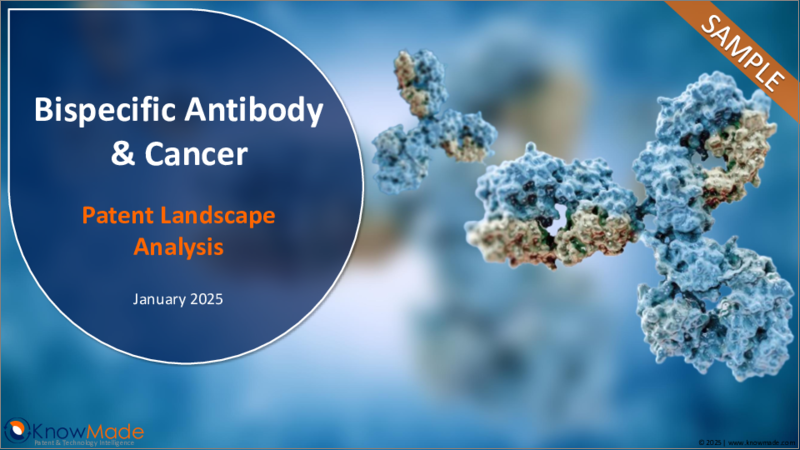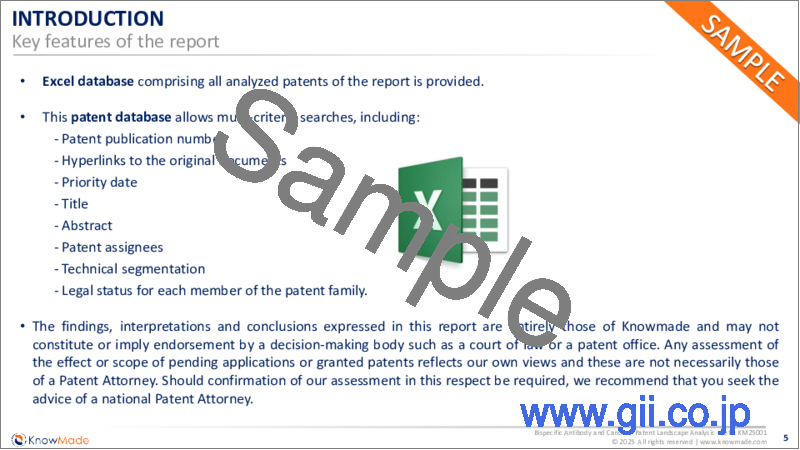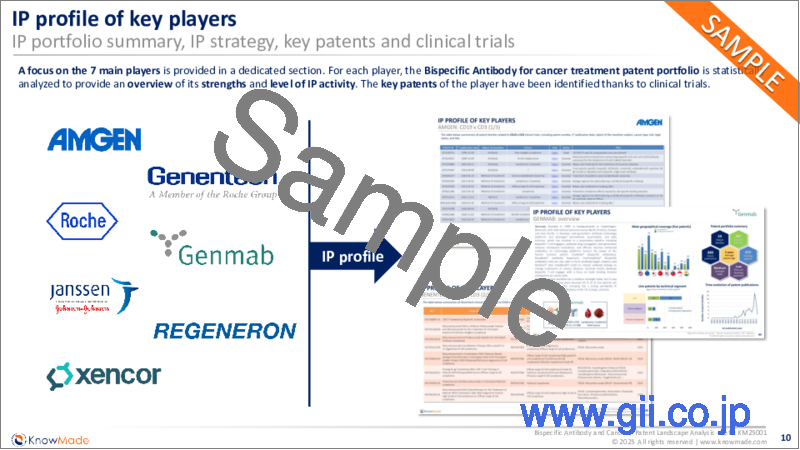|
|
市場調査レポート
商品コード
1650824
二重特異性抗体とがんの特許情勢の分析Bispecific Antibody & Cancer Patent Landscape Analysis |
||||||
|
|||||||
| 二重特異性抗体とがんの特許情勢の分析 |
|
出版日: 2025年01月31日
発行: KnowMade
ページ情報: 英文 PDF>120 Slides, Excel file: 2895 Patent Families
納期: 即日から翌営業日
|
全表示
- 概要
- 目次
二重特異性抗体はがん治療のブレークスルーとなるIPです。
BsAbは新薬の設計と開発にエキサイティングな機会を提供し、永続的な治療効果が期待されます。
がんにおける二重特異性抗体(bsAb)の開発は、著しい臨床的進歩を伴って急速な成長を示しています。近年のデータによると、臨床試験中のbsAbの85%超はがん治療薬であり、現在約600のbsAbが臨床試験中です。現在までに11種類のbsAbががん治療薬として承認されており、そのうち10種類は米国FDAによるものです。このような拡大は、この革新的な治療薬に対する関心の高まりを反映しています。二特異性抗体は、2つの異なる抗原に同時に結合するように設計されたタンパク質です。二重特異性抗体は、2種類の細胞の橋渡しをしたり(in-trans結合)、1つの細胞の膜上の2つの分子に結合したり(in-cis結合)します。細胞の橋渡しをするBsAbがもっとも大きなグループであり、T細胞リダイレクションがもっとも一般的です。T細胞エンゲージャーは細胞傷害性T細胞と腫瘍細胞の両方に結合し、腫瘍に対する直接的な免疫反応を促進します。近年、複数のbsAbが承認されました。2024年12月、米国FDAは、ニューレグリン1(NRG1)遺伝子融合体を保有し、全身療法前または全身療法後に病勢進行した切除不能または転移性の進行性非小細胞肺がん(NSCLC)、またはNRG1遺伝子融合体を保有し、全身療法前または全身療法後に病勢進行した切除不能または転移性の進行性膵臓腺がんの成人患者を対象に、HER2 x HER3 bsAbの早期承認を認めました。しかしながら、生産の複雑性、毒性(サイトカイン放出症候群、免疫エフェクター細胞関連神経毒性症候群、輸液関連反応)、分子の安定性と半減期を最適化する必要性などの課題が残っています。これらの障害を克服するために、先進の抗体工学技術や新しい分子フォーマットの開発などの革新的アプローチが模索されています。

1986年から2000年代初頭にかけて、特許公開件数は少ないながらも増加しています。2010年以降、この分野は大きく加速し、2023年に400を超える特許ファミリーが誕生しています。1980年代、1990年代、そして2000年代初頭には、初の非対称フォーマットの開発、初のT細胞リダイレクションの実証、初の組換えフラグメントベースのフォーマット、種を限定したLCペアリングによる軽鎖(LC)会合問題の初の解決、相補的な重鎖(HC)と共通LCの使用による鎖会合問題の最初の解決、初の対称型フォーマット、天然のヒトIgG4が二重特異性であることの発見、二重可変ドメイン-Ig対称型フォーマットの開発など、学術研究において多くの進歩がなされました。これらすべての革新がbsAbの確立に寄与しました。そして2009年、bsAbのcatumaxomab(Tリンパ球抗原CD3 x 上皮細胞接着分子(EpCAM))が、悪性腹水の治療薬として欧州連合(EU)の承認を取得しました。その5年後、blinatumomab(CD3xBリンパ球抗原CD19)がFDAに承認されました。2015年にEUでも承認されています。
セグメント分析

主要企業のIPプロファイル


当レポートでは、二重特異性抗体とがんの特許情勢について調査分析し、公開特許の時系列推移、特許出願国、特許の法的地位などのIPの動向に加え、主な特許権者のランキングや、主要企業のIPポジションと特許ポートフォリオの相対的強さなどの情報を提供しています。
目次
イントロダクション
エグゼクティブサマリー
特許情勢の概要
- 特許公開の時系列推移
- もっとも多くの特許出願を行った企業のランキング
- 主要企業の現在の法的地位
- コーパスの特許法的地位
- 現在の主要IP保有者のマッピング
- 主な特許権者の時系列推移
新規参入企業
- スタートアップ企業
- 老舗企業
提携
主な出願者のIPポジション
- 特許出願者のIPリーダーシップ
- 特許出願者のIP先行技術によるブロックの可能性
- 主要特許
- 特許ポートフォリオの強度指数
主なEP特許異議申立
特許のセグメンテーション
- 定義
- 主な特許権者:技術別
- CD3
- 免疫チェックポイント
- 腫瘍抗原
主要企業のIPプロファイル
概要、主要特許、臨床試験
- Amgen
- Genentech
- Roche
- GenMab
- Janssen
- Regeneron
- Xencor
調査手法
KnowMadeのプレゼンテーション
お問い合わせ
Bispecific Antibodies Mark a Breakthrough in Cancer Therapy Intellectual Property.
Report's Key Features:
- IP trends, including time evolution of published patents, countries of patent filings and patents' legal status
- Ranking of main patent assignees
- Key players' IP position and relative strength of their patent portfolios
- Segmentation: Tumor Antigens (ERBB family, BCMA, BRCA, mesothelin, PSMA, CEA, claudin, EPCAM, mucin, NKG2D, VEGF, CEACAM, MAGE, ROR1, c-Met and nectin), Immune Checkpoints (PD1 / PDL1, CTLA-4, LAG-3, TIM-3, OX40, ICOS, B7-H3, TIGIT and BTLA) and T cells (CD3).
- Analysis of collaborations and EP patent oppositions.
- Excel database containing all patents analyzed in the report, including segmentations + hyperlink to updated online database (legal status, documents etc.)
BsAbs offer exciting opportunities for the design and development of new drugs, and are expected to have lasting therapeutic impact
The development of bispecific antibodies (bsAbs) in oncology is experiencing rapid growth, accompanied by significant clinical advancements. According to recent data, more than 85% of bsAbs in clinical trials are cancer treatments, with approximately 600 bsAbs currently in clinical trials. To date, 11 bsAbs have received regulatory approval for use in cancer, ten of them by the US FDA. This expansion reflects the growing interest in these innovative therapeutic agents. Bispecific antibodies are engineered proteins designed to bind simultaneously to two distinct antigens. They can bridge two cell types (in-trans binding) or engage two molecules on the membrane of one cell (in-cis binding). BsAbs that bridge cells represent the largest group, with T cell redirection as the most common denominator. T-cell engagers bind both cytotoxic T cells and tumor cells, promoting a direct immune response against the tumor. Several bsAbs have recently received regulatory approvals. In December 2024, the U.S. FDA granted accelerated approval of a HER2 x HER3 bsAb for adults with advanced, unresectable, or metastatic non-small cell lung cancer (NSCLC) harboring a neuregulin 1 (NRG1) gene fusion with disease progression on or after prior systemic therapy, or advanced, unresectable, or metastatic pancreatic adenocarcinoma harboring an NRG1 gene fusion with disease progression on or after prior systemic therapy. However, challenges remain, such as the complexity of production, toxicities (cytokine release syndrome, immune effector cell-associated neurotoxicity syndrome, infusion-related reactions), and the need to optimize the stability and half-life of the molecules. Innovative approaches, such as advanced antibody engineering technologies and the development of new molecular formats, are being explored to overcome these obstacles. Understanding the intellectual property position and strategy of these various players is crucial in this evolving context. Detecting business risks and opportunities, anticipating emerging technologies, and enabling strategic decisions to strengthen market position can be achieved through this knowledge.

Between 1986 and the early 2000s, the number of patent publications is low but increasing. From 2010, the field is experiencing a significant acceleration, culminating in 2023 with more than 400 patent families. In the 1980s and 1990s and early 2000s, many advances were made in academic research such as the generation of the 1st asymmetric format, the 1st demonstration of T cell redirection, the 1st recombinant fragment-based formats, the 1st solution to light chain (LC) association issue through species-restricted LC pairing, the 1st solution to chain-association issue through use of complementary heavy chain (HC) (knobs into holes) and common LC, the 1st symmetric format, the discovery that natural human IgG4 is bispecific, the dual variable domain-Ig symmetric format pioneered, etc. All these innovations have contributed to the establishment of bsAbs. Then, in 2009, the bsAb catumaxomab (a T lymphocyte antigen CD3 x epithelial cell adhesion molecule (EpCAM)) received the European Union approval for the treatment of malignant ascites. Five years later, the blinatumomab (CD3xB lymphocyte antigen CD19) was FDA approved. It has been approved in the EU in 2015.
Analysis by segment
Bispecific Ab & Cancer have been investigated and the selected patent families labeled according to technologies to which they relate. This IP landscape features the following 3 types of segmentation: Tumor Antigens (ERBB family, BCMA, BRCA, mesothelin, PSMA, CEA, claudin, EPCAM, mucin, NKG2D, VEGF, CEACAM, MAGE, ROR1, c-Met and nectin), Immune Checkpoints (PD1 / PDL1, CTLA-4, LAG-3, TIM-3, OX40, ICOS, B7-H3, TIGIT and BTLA) and T cells (CD3).

EP oppositions
Currently, there is a significant number of EP oppositions which reflects the strategic issues of bispecific antibody & cancer for companies. For each opposed patent, the application date, assignee, opponent, opposition year, and results are detailed.
Identifying the companies that have recently emerged in the IP landscape
Among the players owning patent families related to Bispecific Ab & cancer, 52 newcomers were identified. These companies are either start-up firms (6) or established companies (46) developing their first technology in the field. Most IP newcomers are based in the U.S. and in Asia. It is possible that one of these innovative companies could become one of the next healthcare unicorns that the big corporations will be tempted to acquire.
IP profile of key players
This IP study includes a selection and description of main players. The patent portfolio analysis of main players includes a description of the assignee, patent portfolio description, time evolution of patent publication, main geographical coverage and live patents by technical segment. This IP profile overview is followed by the description of the technological content of their key patents and by a table with its clinical trials.


Moreover, the report includes an Excel spreadsheet with the 2895 patent families analyzed in this study. This useful patent database allows for multi-criteria searches and includes patent publication numbers, hyperlinks to the original documents, priority dates, titles, abstracts, patent assignees, each patent's current legal status and segmentation. The report also includes a Patent Online Database which legal status are updated for each patent document.
Companies mentioned in this report (non-exhaustive list):
ROCHE, AMGEN, JANSSEN, GENMAB, XENCOR, REGENERON PHARMACEUTICALS, GENENTECH - ROCHE, MACROGENICS, DRAGONFLY THERAPEUTICS, SANOFI, CHUGAI PHARMACEUTICAL, MERCK MSD, MERUS, BMS, SAMSUNG, JIANGSU HENGRUI PHARMACEUTICALS, ABBVIE, HEFEI TG IMMUNOPHARMA, MARENGO THERAPEUTICS, etc.
TABLE OF CONTENTS
INTRODUCTION
- BsAb for cancer therapy
- Scope of the report
- Reading guide
- Main patent assignees
EXECUTIVE SUMMARY
PATENT LANDSCAPE OVERVIEW
- Time evolution of patent publications
- Ranking of most prolific patent applicants
- Current legal status of the main players
- Patent legal status of the corpus
- Mapping of main current IP holders
- Time evolution of main patent assignees
NEWCOMERS
- Startup companies
- Established companies
COLLABORATIONS
IP POSITION OF MAIN APPLICANTS
- IP leadership of patent applicants
- IP prior art blocking potential of patent applicants
- Key patents
- Strength index of patent portfolios
MAIN EP PATENT OPPOSITIONS
PATENT SEGMENTATION
- Definition
- Main assignees by technology
- CD3
- Immune Checkpoint
- Tumor Antigen
IP PROFILE OF KEY PLAYERS
Overview, key patents & clinical trials of:
- Amgen
- Genentech
- Roche
- GenMab
- Janssen
- Regeneron
- Xencor
METHODOLOGY
- Patent search, selection and analysis
- Search strategy
- Terminologies for patent analysis
- Strength and blocking potential






